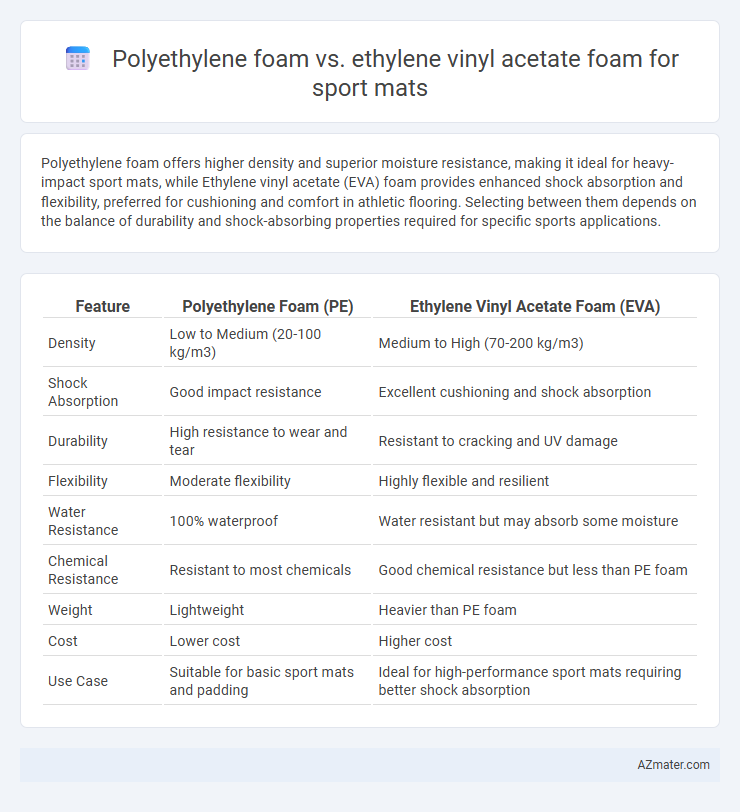Polyethylene foam offers higher density and superior moisture resistance, making it ideal for heavy-impact sport mats, while Ethylene vinyl acetate (EVA) foam provides enhanced shock absorption and flexibility, preferred for cushioning and comfort in athletic flooring. Selecting between them depends on the balance of durability and shock-absorbing properties required for specific sports applications.
Table of Comparison
| Feature | Polyethylene Foam (PE) | Ethylene Vinyl Acetate Foam (EVA) |
|---|---|---|
| Density | Low to Medium (20-100 kg/m3) | Medium to High (70-200 kg/m3) |
| Shock Absorption | Good impact resistance | Excellent cushioning and shock absorption |
| Durability | High resistance to wear and tear | Resistant to cracking and UV damage |
| Flexibility | Moderate flexibility | Highly flexible and resilient |
| Water Resistance | 100% waterproof | Water resistant but may absorb some moisture |
| Chemical Resistance | Resistant to most chemicals | Good chemical resistance but less than PE foam |
| Weight | Lightweight | Heavier than PE foam |
| Cost | Lower cost | Higher cost |
| Use Case | Suitable for basic sport mats and padding | Ideal for high-performance sport mats requiring better shock absorption |
Introduction to Polyethylene Foam and Ethylene Vinyl Acetate Foam
Polyethylene foam (PE foam) is a closed-cell, lightweight material known for its excellent shock absorption, water resistance, and durability, making it ideal for sport mats requiring high impact protection and moisture control. Ethylene vinyl acetate (EVA) foam is a flexible, soft, and resilient material with superior cushioning, elasticity, and UV resistance, commonly used in sport mats for enhanced comfort and injury prevention. Both foams offer distinct advantages in sports applications depending on desired firmness, durability, and environmental exposure.
Key Properties of Polyethylene Foam
Polyethylene foam offers excellent impact absorption, high resilience, and superior water resistance, making it ideal for sport mats requiring durability and comfort. Its closed-cell structure provides excellent insulation and resistance to chemicals, oils, and moisture, enhancing longevity during intense physical activities. Compared to Ethylene vinyl acetate foam, polyethylene foam excels in stiffness and tear resistance, ensuring sustained performance under heavy use.
Key Properties of Ethylene Vinyl Acetate Foam
Ethylene vinyl acetate (EVA) foam offers superior shock absorption, flexibility, and durability compared to polyethylene foam, making it ideal for sport mats where impact resistance and comfort are critical. EVA foam features a closed-cell structure that provides water resistance and excellent cushioning while maintaining lightweight properties. Its enhanced elasticity and resilience withstand repeated use and heavy foot traffic, ensuring long-lasting performance in athletic environments.
Shock Absorption Comparison for Sports Mats
Polyethylene foam offers excellent shock absorption due to its closed-cell structure, providing durable cushioning and impact resistance ideal for sports mats used in high-impact activities. Ethylene vinyl acetate (EVA) foam features superior elasticity and soft resilience, enhancing energy return and reducing injury risk by absorbing and dispersing shocks effectively during athletic movements. While polyethylene foam excels in long-term durability and compression resistance, EVA foam is preferred for its comfort and enhanced shock absorption in sports mats requiring flexibility and lightweight properties.
Durability and Longevity in Athletic Applications
Polyethylene foam offers superior durability and impact resistance, making it ideal for sport mats that endure heavy use and repeated stress. Ethylene vinyl acetate (EVA) foam provides excellent cushioning and flexibility but tends to compress over time, reducing its longevity under rigorous athletic activities. For long-term performance and resilience in high-impact applications, polyethylene foam typically outperforms EVA foam in maintaining structural integrity and shock absorption.
Comfort and Cushioning Performance
Polyethylene foam offers excellent durability and firm cushioning with high resilience, making it suitable for sports mats requiring strong impact absorption and support. Ethylene vinyl acetate (EVA) foam provides superior softness and elasticity, enhancing comfort with its lightweight and shock-absorbing properties that reduce joint stress during activities. Choosing EVA foam maximizes comfort and cushioning performance for prolonged use, while polyethylene foam prioritizes stability and resistance under heavy impact.
Water and Sweat Resistance
Polyethylene foam exhibits superior water and sweat resistance compared to Ethylene vinyl acetate (EVA) foam, making it an ideal choice for sport mats in high-moisture environments. Its closed-cell structure prevents water absorption and inhibits bacterial growth, enhancing durability and hygiene during intense workouts. EVA foam, while softer and more cushioned, tends to absorb sweat and moisture more readily, which can lead to odor retention and quicker material degradation.
Environmental Impact and Recyclability
Polyethylene foam offers moderate environmental impact with limited recyclability, often ending up in landfills due to its lower biodegradability. Ethylene vinyl acetate (EVA) foam is less environmentally friendly, as its complex chemical composition complicates recycling and increases persistence in ecosystems. Both materials require improved waste management strategies to reduce their footprint in the sports mat industry.
Cost Analysis: Polyethylene vs. EVA Foam
Polyethylene foam offers a cost-effective solution for sport mats, with lower material and production expenses compared to Ethylene Vinyl Acetate (EVA) foam, making it ideal for budget-conscious projects. EVA foam, while more expensive due to its superior cushioning, flexibility, and durability, provides enhanced shock absorption and comfort, justifying the higher price in high-performance applications. The price difference typically ranges from 20% to 50%, influenced by density, thickness, and supplier, affecting the overall cost analysis for sports equipment manufacturers and consumers.
Best Choice: Selecting the Ideal Foam for Sport Mats
Polyethylene foam offers superior impact absorption and durability, making it ideal for high-traffic sport mats requiring long-term resilience. Ethylene vinyl acetate (EVA) foam provides excellent flexibility and cushioning, enhancing comfort and shock attenuation, especially suitable for yoga or gymnastics mats. Selecting the ideal foam depends on prioritizing either longevity and firmness with polyethylene or enhanced comfort and elasticity with EVA.

Infographic: Polyethylene foam vs Ethylene vinyl acetate foam for Sport mat
 azmater.com
azmater.com